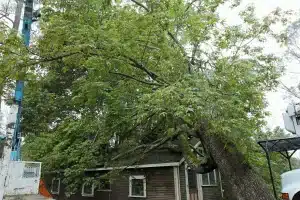As we head into the colder months, it’s the perfect time to assess the health of the trees on your property. Dying trees can pose a serious threat to your landscape, your home, and even your safety if not managed properly. Whether it’s from disease, pests, or the harsh effects of winter weather, a dying tree should not be ignored. At Sandborn Tree Service, we’re here to guide you through the process of diagnosing and caring for your dying tree to prevent further damage.
Signs of a Dying Tree
The first step in tending to a dying tree is identifying the signs. If you notice any of the following, it might be time to take action:
- Dead or brittle branches: When you snap a branch and it easily breaks, this is a strong indicator that the tree is unhealthy.
- Yellowing leaves or leaf loss: Healthy trees retain their foliage through fall, while a dying tree will shed its leaves prematurely or have yellowing foliage.
- Bark decay: If the bark is peeling or falling off in large sections, this may suggest disease or pests at work.
- Unusual growths or fungus: Seeing fungi growing on the trunk or roots could indicate a deeper issue, like rot.
- Cracks or splits in the trunk: A cracked or split trunk is a serious sign that the tree is structurally compromised.
If your tree is showing any of these signs, it’s time to take action before the problem worsens.
What You Can Do for Your Dying Tree
Once you’ve identified that your tree might be dying, here are the key steps to take:
Prune Dead or Diseased Branches
Pruning is one of the most important aspects of tree care, especially for a tree that is showing signs of decline. Remove any dead, diseased, or damaged branches to improve the overall health of the tree and prevent the spread of disease. Make sure you use clean, sharp tools to avoid further injury to the tree. Pruning also helps to improve air circulation, which is essential in preventing fungal infections.
Ensure Proper Watering and Mulching
A dying tree might not be getting the nutrients it needs, and this could be due to improper watering or poor soil health. Water your tree consistently, especially during dry periods, but avoid over-watering, as this can cause root rot. Apply a thick layer of mulch around the base of the tree, which helps retain moisture and regulate soil temperature, especially during the winter months.
Monitor for Pests
Many trees suffer from pest infestations that can lead to decline. Look for signs of pests like holes in the bark, sawdust around the base, or insects on the leaves. If you spot pests, consult an expert to determine the best course of treatment. Pesticides may be necessary, but they should only be applied by professionals to ensure they’re used effectively.
Consider Cabling and Bracing
If your tree is structurally unstable but otherwise healthy, cabling and bracing might be a viable option to provide support. This method involves installing steel cables to reduce the risk of further damage during storms or high winds. It’s a proactive way to save trees that are still alive but at risk of breaking under stress.
Consult a Professional Tree Care Service
Sometimes, despite your best efforts, a tree may be too far gone to save. If you’ve tried to address the problem but the tree is still dying, it’s essential to consult a professional. A certified arborist from Sandborn Tree Service can assess the situation, recommend the best course of action, and even help with safe removal if necessary. With our expertise, we can ensure your landscape stays healthy and safe.
Don’t Wait — Act Now
If you’re worried about a dying tree on your property, don’t wait until it becomes a bigger issue. Whether you’re dealing with disease, pests, or weather damage, we at Sandborn Tree Service can help. Our team of experts specializes in tree care, from pruning to removal, ensuring that your trees are healthy and safe year-round.
Contact Sandborn Tree Service today for a consultation or free estimate!
Taking care of a dying tree can be daunting, but with the right steps and professional help, you can preserve the beauty and safety of your landscape. Don’t let your tree suffer—reach out to Sandborn Tree Service for expert advice and services. We’re here to ensure that your trees get the care they deserve this winter.





